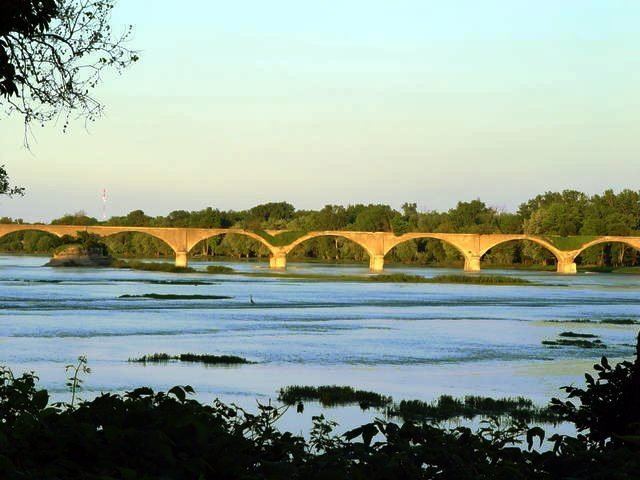Architect National Bridge Co. NRHP Reference # 72001036 Opened 1908 | Built 1908 Architectural style Other Address Waterville, OH 43566, USA Area 4,047 m² Added to NRHP 19 June 1972 | |
 | ||
Similar Farnsworth Metropark, Portage Hike & Bike Trail ‑ Fra, Maple Highlands Trail, Columbian House, Black River Reservation | ||
Rouche de boeuf interurban bridge in waterville over maumee river
The Interurban Bridge, also known as the Ohio Electric Railroad Bridge. is a historic interurban railway reinforced concrete multiple arch bridge built in 1908 to span the Maumee River joining Lucas and Wood counties near Waterville, Ohio. The span was once the world's largest earth-filled reinforced concrete bridge. It is within the Farnsworth Metropark and is the river crossing of the park's trail system, which connects this park with Bend View and Providence Metroparks. One of the bridge's supports rests on the Roche de Boeuf, a historic Indian council rock, which was partially destroyed by the bridge's construction.
Contents
- Rouche de boeuf interurban bridge in waterville over maumee river
- Perilous interurban bridge 2016
- Builder Lima Toledo Traction
- Final railway use by the Cincinnati and Lake Erie Railroad
- References
Perilous interurban bridge 2016
Builder Lima-Toledo Traction
The bridge has been abandoned for many years. It was constructed by the Lima-Toledo Traction company, an interurban trolley line that ran primarily adjacent to the Baltimore and Ohio steam railroad from Toledo to Lima, Ohio, and by connection to Dayton. Many Ohio interurban lines struggled financially from inception. In an attempt to create operational efficiency under one management, the L-T was brought under lease control of the Ohio Electric corporation along with other Ohio interurbans to form a large widespread Ohio interurban network. All equipment was relettered and operated as the Ohio Electric. Financially the consolidation didn't work, and when the OE went bankrupt, the L-T returned to its former owners and operated as the Lima-Toledo Railroad and continued interurban service between Toledo and Lima.
Final railway use by the Cincinnati and Lake Erie Railroad
In 1929, two adjacent Ohio interurbans (the Cincinnati Hamilton and Dayton, and the Indiana, Columbus and Eastern) combined with the L-T to form the Cincinnati and Lake Erie Railroad to establish interurban service from Toledo to distant Cincinnati. A branch operated from Springfield to Ohio's capitol Columbus. The corporate goal was to increase passenger business and particularly interurban freight business in this heavily industrialized part of Ohio. From 1929 to 1930, the C&LE borrowed heavily to rebuild track and purchase new passenger and freight equipment in order to provide high speed operation between its major cities of Toledo, Lima, Springfield, Dayton, and Cincinnati. Initially the C&LE was successful and business increased, but the collapsing national and local economy due to the Great Depression of the 1930s, the numerous floods requiring very expensive track rebuilding, the competition from newly paved highways with the related growth of automobile and truck competition reduced C&LE revenue and forced abandonment in 1937. This was the last year that the Interurban Bridge saw rail traffic. On June 19, 1972, it was added to the National Register of Historic Places
